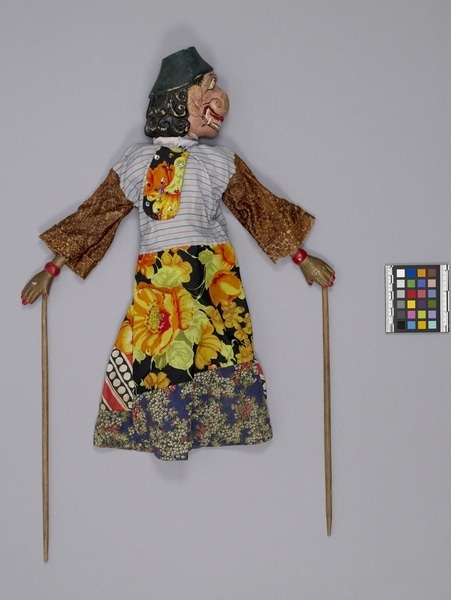Rod Puppet Item Number: Ib282 a-c from the MOA: University of British Columbia


Description
Three-dimensional monstrous humanoid puppet: large head (part b) fits into body with long tunic (part a), and a control rod (part c) with a long shaft passes through the body and fits into the neck of the figure's head. The body has jointed arms, each with a long controlling rod attached. Large head, dominated by swollen nose, with large eyes and red irises. Wide toothy mouth with double hooked teeth in each corner and wide, red lips. Whiskers, mouth, ring, ears, brown, and eyes outlined in black. Shoulder length black hair in curls, and a dark green hat. Face two colours, vertically split: pale green on the figure's right, and pink to the figure's left. Arms and hands painted gold, with bracelets and nails red. Hands are flat, with fingers extended. Clothed in full length tunic of six different multicoloured fabrics. Light purple upright collar; top, light blue with red and blue stripes; middle section (and jabot, the oval flap hanging from neck) made from synthetic black fabric with bright green, orange, red and yellow floral print. Jabot decorated with sequins and beads. Lower section of tunic: red, white and green flowers on a dark blue background. Black, red, white diagonal stripes with white dots on reverse. Sleeves are made of light and dark brown sythetic material.
History Of Use
Javanese puppetry as an art form probably developed by the 11th century. The three-dimensional wooden wayang golek puppets of western Java, which are to be distinguished from the earlier and more sacred wayang kulit shadow plays puppets or other forms, appeared during the 16th century. Originally the plays depicted Javanese mythology, but after the Indian conquest of Java the Hindu epics, Ramayana and Mahabharata, were incorporated into the cycles, which comprise about 200 plays. An individual or group hires a dalang (puppet-master) to celebrate important occasions. The performances often last all night and are generally presented in three acts, with vocal and instrumental accompaniment. The individual plays vary widely in detail but usually involve conflict between good and evil. They serve a moral and religious purpose, and more recently, one of political commentary. Each puppet's character is represented by its appearance and placement onstage; protagonists with strong elements of good are placed to the right, antagonists of violent or evil nature to the left. The unrefined, coarse and violent features of the buta class of ogres also define their temperament onstage. As such they are wild and unpredictable. They appear in almost all of the plays, in the role of the destructive force of evil. There are many variations in the form of demons; many appear in each set. However, the puppet of Buta Terong has a more fixed role and is identifiable immediately by his appearance.
Iconographic Meaning
Unrefined, coarse and even monstrous features identify the puppet as a demon of the buta class. Most of their traits are characteristic of kasar (evil) rather than noble or holy (alus) figures. Extended hands indicate ordinary or demonic ancestry. Dual face colour may represent dual character. Red faces typically show violent, treacherous, and cruel nature; green face is uncommon: its significance is unclear but can be considered particularly negative. Jabot is also unusual, typically identified with wealthy or highly ranked roles: servants and workers never wear jabots. Puppet identified with the Buta Terong, who has a relatively fixed role.
Cultural Context
Theatrical performance.
Item History
- Made in Java, Indonesia
- Owned by Tradewind Antiques before March 15, 1983
- Received from Museum of Anthropology Shop Volunteers (Funding source) and Tradewind Antiques (Seller) on March 15, 1983
What
- Name
- Rod Puppet
- Identification Number
- Ib282 a-c
- Type of Item
- puppet
- Material
- wood, synthetic fibre, fibre, paint, plastic and glass
- Manufacturing Technique
- carved, painted, spun, machine woven, machine sewn and sewn
- Part A
- height 55.0 cm, width 15.5 cm, depth 8.0 cm
- Part B
- height 15.0 cm, width 6.5 cm, depth 11.0 cm
- Part C
- height 37.1 cm, width 2.0 cm, depth 1.2 cm
Who
- Culture
- Sundanese
- Previous Owner
- Tradewind Antiques
- Received from
- Museum of Anthropology Shop Volunteers (Funding source) and Tradewind Antiques (Seller)
Where
- Holding Institution
- MOA: University of British Columbia
- Made in
- Java, Indonesia
When
- Ownership Date
- before March 15, 1983
- Acquisition Date
- on March 15, 1983
Other
- Condition
- fair
- Accession Number
- 0886/0016 a-c